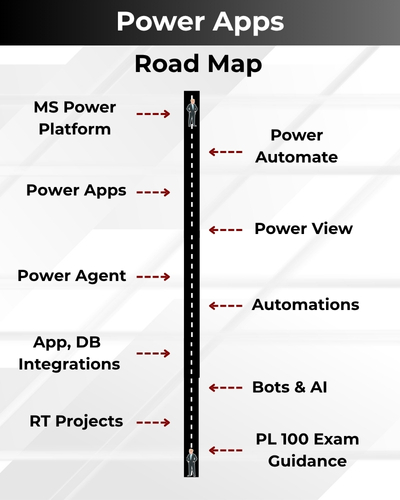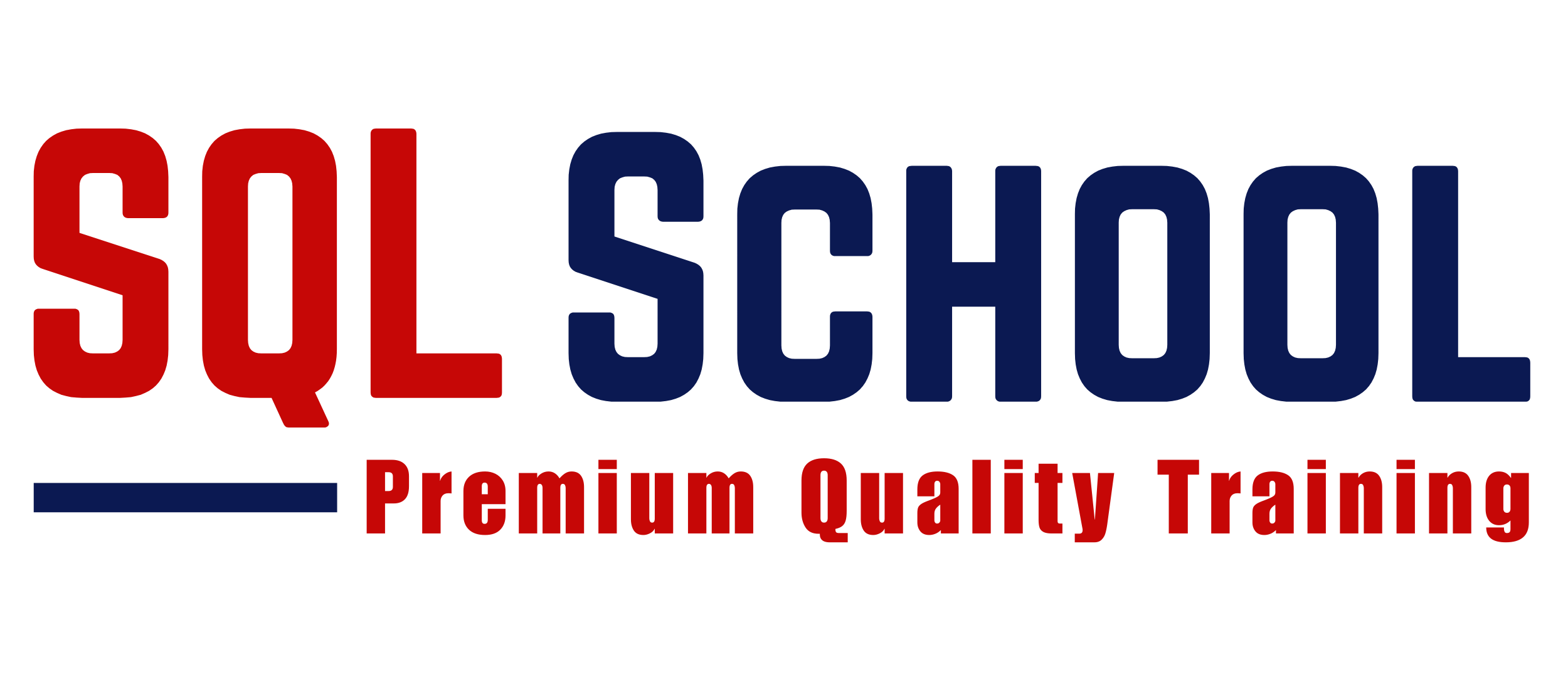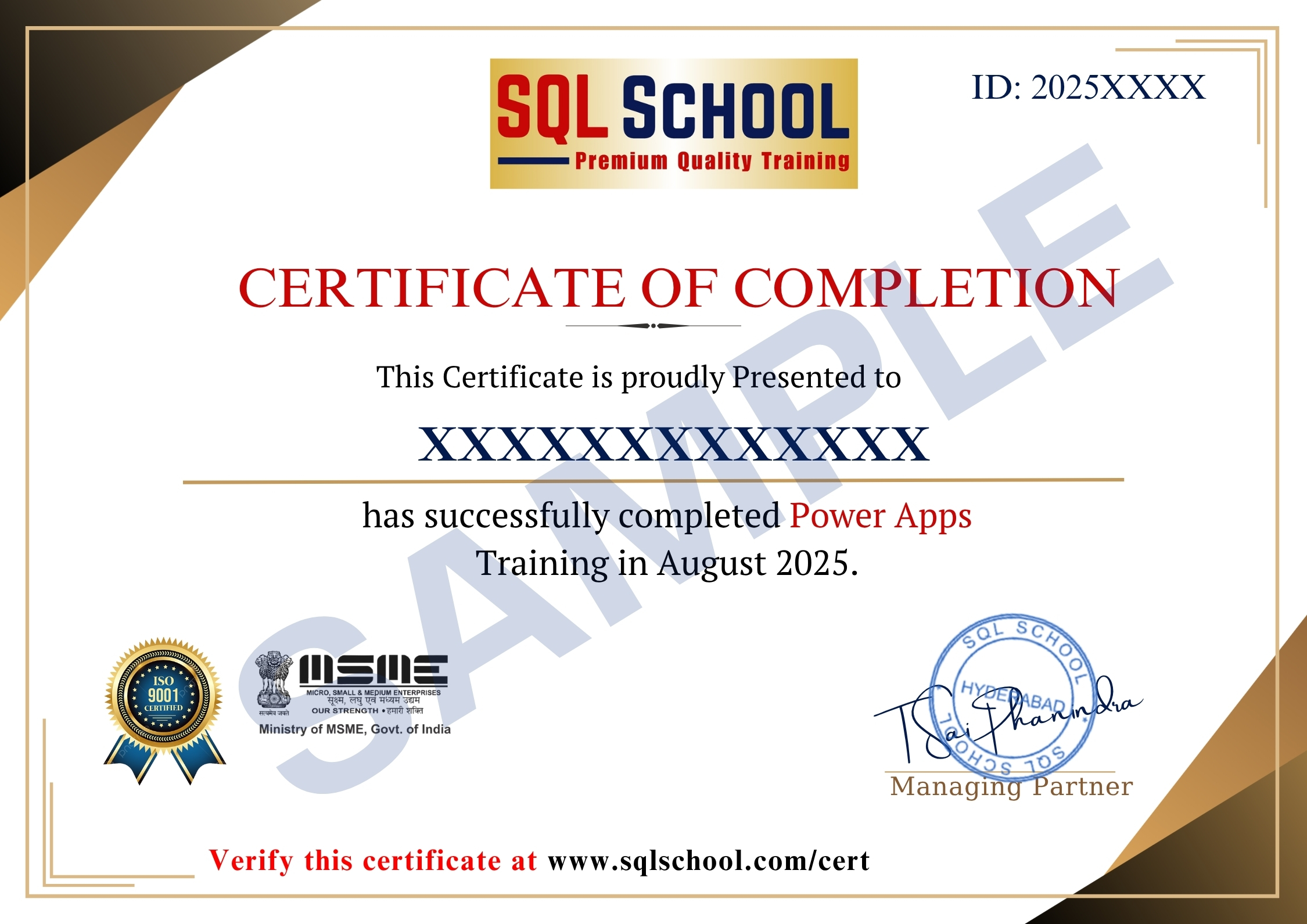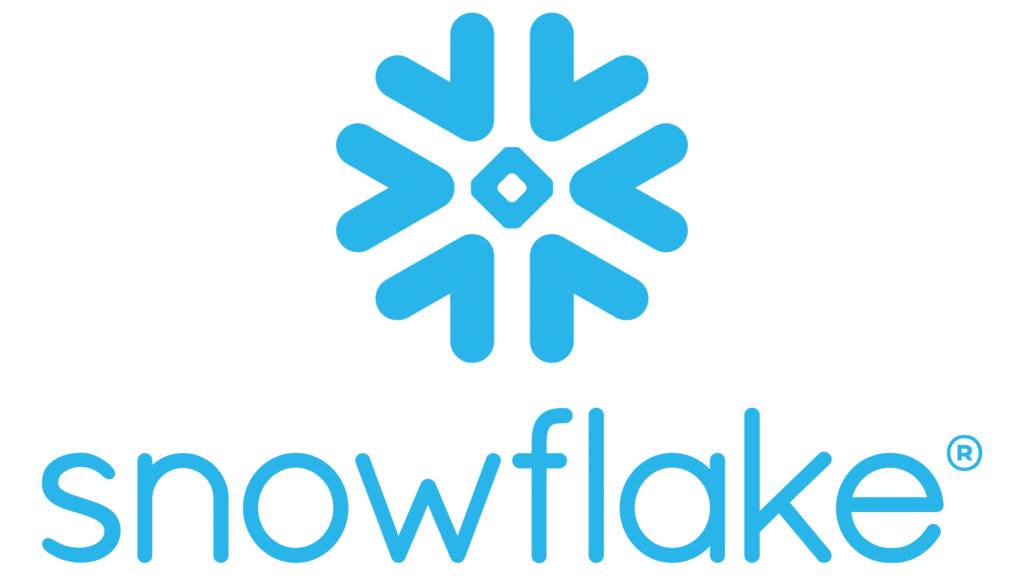
Power Apps is a powerful low-code platform from Microsoft that enables users to design, develop, and deploy custom business applications with ease. It integrates seamlessly with Power BI, Microsoft 365, and Dynamics 365, helping organizations automate workflows, improve efficiency
✅ Power Apps & Microsoft Power Platform
✅ Canvas Apps, Model-Driven Apps
✅ Data Connections with SharePoint
✅ App Design, Layouts & UI Customization
✅ Business Logic Implementation
✅ Power Automate & Power FX Integration
✅ Security, Permissions & Environment Management
✅ Integration with Power BI, Dataverse & SQL Server
✅ End-to-End Real-Time Power Apps Project
✅ Exam Prep, Mock Interviews & 1:1 Mentorship
ETL Developer Training
Course Contents:
Module 1 : Microsoft SQL (TSQL)
Ch 1: SQL SERVER INTRODUCTION
- Database Introduction
- Types of Databases
- Need for & ETL, DWH
- BI Implementations
- SQL Server Advantages
- Version, Editions of MSSQL
- Data Analyst Job Roles
Ch 2: SQL SERVER INSTALLATIONS
- SQL Server 2019, 2017
- SSMS Tools Installation
- Database Engine (OLTP)
- SCM, Configuration Tools
- Instance Types, Uses
- Authentication Modes
- Collation, File Stream
Ch 3: SQL BASICS – 1
- Need for Databases, Tables
- Need for SQL Commands
- DDL, DML & DQL Statements
- Database Creation @ GUI
- Data Operations @ GUI
- Session ID, SQL Context
- DB, Tables, Data @ SQL
Ch 4: SQL BASICS – 2
- DDL Variants in MSSQL
- DML Variants in MSSQL
- INSERT & INSERT INTO
- SELECT & SELECT INTO
- Basic Operators in SQL
- Special Operators in MSSQL
- ALTER, ADD, TRUNCATE, DROP
Ch 5: Data Imports, Schemas
- Data Imports with Excel
- ORDER BY & UNION
- UNION ALL For Sorting Data
- Creating, Using Schemas
- Real-world Banking Database
- Table Migrations @ Schemas
- 2 Part, 3 Part & 4 Part Naming
Ch 6 : Constraints, Index Basics
- Need for Constraints, Keys
- NULL, NOT NULL, UNIQUE
- Primary Key & Foreign Key
- RDBMS and ER Models
- Identity Property, Default
- Clustered Index, Primary Key
- Non Clustered Index, Unique
Ch 7: Joins & Views Basics
- JOINS: Purpose. Inner Joins
- Left / Right / Full Outer Joins
- Cross Joins, Query Tuning
- Creating & Using Views
- DML, SELECT with Views
- RLS : WITH CHECK OPTION
- System Views & Metadata
Ch 8: Functions(UDF), Data Types
- Using Functions in MSSQL
- Scalar Value Functions
- Inline & Multiline Functions
- Date & Time Functions
- String, Aggregate Functions
- Data Types : Integer, Char, Bit
- SQL Variant, Timestamp, Date
Ch 9: Stored Procedures,Models
- Stored Procedures & Usage
- Creating, Testing Procedures
- Encryption, Deferred Names
- SPs for Validations, Analysis
- System SPs, Recompilation
- Normal Forms & Types
- Data Models, Self-References
Ch 10: Triggers, Temp Tables
- Need for Triggers
- DDL & DML Triggers
- Using Memory Tables
- Data Replication, Automation
- Local & Global Temp Tables
- Testing & Using Temp Tables
- SELECT .. INTO & Bulk Loads
Ch 11: DB Architecture, Locks
- Planning VLDBs : Files, Sizing
- Filegroups, Extents & Types
- Log Files : VLF, Mini LSN
- Table Location, Performance
- Schemas, Transfer, Synonyms
- Transactions Types, Lock Hint
- Query Blocking Scenarios
Ch 12 : Cursors & CTEs, Links
- Cursors : Realtime Use
- Fetch & Access Cursor Rows
- CTEs for SELECT, DML
- CTEs: Scenarios & Tuning
- Linked Servers, Remote Joins
- Linked Servers: MSDTC, RPC
- Tuning Remote Queries
Ch 13: Merge, Upsert & Rank
- Need for Merge in ETL
- Incremental Loads with SQL
- MERGE and RANK Functions
- Window Functions, Partition
- Identify, Remove Duplicates
Ch 14: Grouping & Cube
- Group By & HAVING
- Cube, Rollup & Grouping
- Joins with Group By
- 3 Table, 4 Table Joins
- Query Execution Order
Ch 15: Self Joins, Excel Analysis
- Self Joins & Self References
- UNION, UNION ALL
- Sub Queries with Joins
- IIF, CASE, EXISTS Statements
- Excel Analytics, Pivot Reports
Module 2: Azure Data Engineer
Ch 1: ETL, DWH Introduction
- Database Introduction Data Warehouse (DWH)
- Data Engineering Work Flow
- Cloud Concepts: IaaS, PaaS
- SaaS & Azure Cloud Concepts
- Azure Resources & Groups
- Storage, ETL, IoT Resources
Ch 2: Azure Intro, Azure SQL
- Azure SQL Server, SQL DBA
- Azure SQL Database (OLTP)
- Azure SQL Pool (DWH)
- Connections from SSMS Tool
- Connections from ADS Tool
- Pause / Resume SQL Pool
- Source Data Configurations
Ch 3: Azure Synapse (DWH)
- Synapse Pool Architecture
- Control Node, Compute Node
- DMS & Partitioned Tables
- Creating Tables with TSQL
- Distributions: RR, Hash, Repl
- Big Data Loads with TQL
- Important DMFs & DMVs
Ch 4: Azure Data Factory (ADF)
- Need for ADF & Pipelines
- Linked Services & IRs
- Datasets, Pipelines, Triggers
- Copy Data Activity & CDT
- Data Loads Pipelines, DTUs
- Pipeline Monitoring, Edits
Ch 5: ADF Incremental Loads – 1
- File Incremental Loads
- Storage Account, Data Lake
- Binary Copy, Schema Drift
- Staging Concept in ADF
- DOCP, Logging & Consistency
- Polybase Concept & Tuning
Ch 6: ADF Incremental Loads – 2
- Implement SCD with ADF
- Self-Hosted IR: Realtime Use
- On-premise Data: Incr Loads
- Copy Method: Upsert, Keys
- Staging & ADF Optimizations
- Pipeline Runs, Activity IDs
Ch 7: ADF Data Flow – 1
- Data Flow Transformations
- Spark Clusters for Debugging
- Optimized Clusters, Preview
- Conditional Split, SELECT
- Sort, Union Transformations
- Pipelines with Data Flow
Ch 8: ADF Data Flow – 2
- Working with Multiple Tables
- Join Transform, Broadcast
- Row Filters, Column Filters
- Surrogate Keys, Derived Cols
- ETL Loads Dates, Sink Options
- Aggregated Data Loads
Ch 9: ADF Data Flow – 3
- Pivot Transformation
- Group By & Pivot Keys
- Column Pattern, Deduplicate
- Lookup, Cached Lookup
- Tuning Transformations
- Tuning Data Flow, Spark
Ch 10: Synapse Analytics – 1
- Azure Synapse Analytics
- Dedicated SQL Pools
- TSQL: Stored Procedures
- Synapse Pipelines, Tuning
- SP Activity in Pipelines, Jobs
- Comparing ADF & Synapse
Ch 11: Synapse Analytics – 2
- Serverless Pools in Synapse
- TSQL Scripts with Serverless
- ADLS Data Imports & ELT
- Synapse Aggregation, Analytics
- Synapse Optimizations
- Synapse Security & Logins
Ch 12: Synapse Analytics – 3
- Apache Spark Pool & Usage
- Synapse Analytics with Pools
- PySpark Staging, Aggregations
- Spark Queries & Python ETL
- Python Notebooks, Pipelines
- Integrating Python with DWH
Ch 13: Parameters, SCD & ETL
- ADF Templates in Realtime
- Table Incremental Loads
- Control Tables, Watermarks
- Pipeline Parameters, SPs
- Dynamic Data Sets, SCD
Ch 14: CDC @ ETL, ELT & Tuning
- Using CDC in ADF
- Control Tables (CT): Upserts
- Handling Inserts, Updates
- SCD Type 1 & Type 2
- ADF, Synapse: Limitations
Ch 15: Azure Intro & Storage
- Storage, ETL, IoT Resources
- Azure Storage Components
- Azure Storage Account, HNS
- Azure Data Lake Storage
- Azure Storage Explorer Tool
- Storage Explorer Config
- Storage Account Properties
Ch 16: Azure Storage Operations
- BLOB Storage: Containers
- Storage Browser, Explorer
- File & Folder Uploads, Edits
- Azure Tables: Row Key
- Partition Key, Timestamp
- Use Cases of BLOB Storage
- Use Cases of Azure Tables
17: Azure Storage Security
- Realtime use of Keys
- Access Keys & Admin Access
- SAS Keys Generation, Ips
- Creating, Using Entra Users
- Azure AD Users, Groups
- IAM & RBAC with Entra Users
- ACLs and ADLS Security
Ch 18: Azure SQL DB Migrations
- On-Premise SQL DB bacpac
- Azure SQL Deployment
- Azure Storage from SSMS
- Azure SQL DB Migration
- Migration Verifications
- Testing Migrations in SQL
Ch 19: Azure Stream Analytics
- Azure IoT Hubs & Devices
- APIs with Connection Strings
- Azure Steam Analytic Jobs
- Inputs, Outputs, SAQL Query
- LIVE Feed: JSON, AVRO Files
- Watermark & LIVE Stats
Ch 20: Azure Stream Analytics
- Azure IoT Hubs & Devices
- APIs with Connection Strings
- Azure Steam Analytic Jobs
- Inputs, Outputs, SAQL Query
- LIVE Feed: JSON, AVRO Files
- Watermark & LIVE Stats
Ch 21: Azure Key Vaults, Alerts
- Azure Encryptions @ REST
- Azure Key Vaults & Keys
- SMK & CMK Encryptions
- Azure Metrics: Ingress
- Egress, E2E Latency Issues
- Performance Tuning Options
Ch 22: Azure Storage Optimization
- BLOB Types & Content Types
- Hot, Cool, Cold, Archive Types
- Creating, Using Access Policies
- Immutable Storage, Rotation
- Containerization, Indexing
- Replication: LRS, ZRS, RA-GRS
Ch 23: Azure Pricing, Functions
- Azure Logic Apps: Usage
- Log Apps Usage in ETL
- Snapshots, Azure Functions
- Azure Functions Realtime Use
- ETL & DWH with Functions
- Azure Resource Pricing
Ch 24: Azure Big Data & Spark
- Azure Big Data & Spark
- Azure ETL & DWH Databases
- Azure Spark, HIVE Metastore
- Azure Databricks Service
- Spark Cluster (Personal)
- Unity Catalog & Azure VM
Ch 25: Spark Cluster Operations
- DBFS: Flat File Imports
- Table Conversions using GUI
- Spark Clusters: Table Creations
- Basic Transformations in Spark
- SQL Notebooks: Creation
- Default DB Queries, Cloning
Ch 26: Python & PySpark, ETL
- Python Fundamentals
- Python Data frames: ETL
- Python for Big Data, Pandas
- Python Notebooks, Views
- Aggregated Loads to Spark
- Spark DB Creations, Tables
Ch 27: PySpark & ADLS, Widgets
- Creating Spark Databases
- Spark Tables, Catalog Info
- PySpark with ADLS Storage
- Using Widgets for ADLS Keys
- PySpark Variables & Widgets
- Using Variables in Functions
- Spark SQL with Control Text
- Using Variables in Spark SQL
Ch 28: ADB Jobs, Delta Tables
- Azure Databrick Jobs
- Azure Workflows & Tasks
- Notebook Schedule Options
- Continuous Jobs, Notifications
- Delta Tables & Data Cleansing
- SCD (Merge Into), Contact, etc.
- Creating, Using Data frames
- Multi Data frame Joins
Ch 29: Scala Notebooks & ETL
- Scala Notebooks: Purpose
- Aggregated Data Loads
- Incremental Data Loads
- Widgets & Jobs with Scala
- Python Versus Scala
- Converting Python to Scala
- JVM Benefits, SQL DB Conn”
- SQL DB Loads with Scala
Ch 30: Databricks Architecture
- Azure Databricks Services
- Cluster Components & DBFS
- RDD, DAG, Photon, Spotlight
- Spark Partitioned Tables
- Cluster Manager: Spark Jobs
- Databricks Runtime (DBR)
- Databricks Security
- Workspace Security
- Notebook & Job Security
Ch 31: Medallion Architecture
- Medallion Architecture in ETL
- DWH Data Loads & Incr Loads
- Bronze, Silver & Gold Data
- Processing Raw Data Files
- Data Cleansing, Formatting
- Aggregation Advantages
- DBES & Node Architecture
- Unity Catalog Concept
- LUNs and Unity Catalog
Ch 32: Delta LIVE Tables (DLT)
- Creating Delta LIVE Tables
- DLT Pipelines in ETL, DWH
- Automated Incr Loads
- Control Tables, Timestamp
- SCD Type 1 with DLT
- SCD Type 2 with DLT
- Automated Merge Into Stmt
- Delta Tables Vs DLT
- Merge Into Vs DLT Pipeline
Module 3: Python for ETL
Ch 1. Python Introduction
- Need for Data Analytics
- Python in Data Analysis
- History of Python
- Python Versions
- Python Implementations
- Python Installations
- Python IDE & Usage
- Jupyter Notebooks
Ch 2. Python Basics, Architecture
- Python Scripting Options
- Basic Operations in Python
- Python Scripts, Print()
- Single, Multiline Statements
- Adding Cells, Saving Notebook
- Single, Multi Line Comments
- Python : Internal Architecture
- Compiler Versus Interpreter
Ch 3. Data Types & Variables
- Integer / Int Data Types
- Float & String Data Types
- Boolean, Binary Types
- Sequence Types: List, Tuple
- Range, Complex & memview
- Retrieving Data Type: type()
- Multi Assignments & Casting
- Unpack Collection, Outputs
Ch 4. Python Operators
- Arithmetic, Assignment Ops
- Comparison Operators
- Logical, Identity Operators
- Member, Bitwise Operators
- Operator Precedence
- If … Else Statement, Pass
- Short Hand If, OR, AND
- ELIF and ELSE IF Statements
- Expressions, Ternary OPs
Ch 5: Python Loops, Iterations
- Python Loop & Realtime Use
- Python While Loop Statement
- Break and Continue Statement
- Using Print with While()
- Iterations & Conditions
- Exit Conditions & For Loops
- Break, Continue & Range
- __iter__() and __next__()
- iter() and Looping Options
Ch 6: Python Collections
- Python Collections (Arrays)
- list() Constructor, print()
- Python Tuples, Tuple Items
- tuple() Constructor, Usage
- Python Sets : Syntax Rules
- Duplicates, Types, Ordered
- Python Dictionaries: Usage
- Changeable, Ordered Data
- Dictionary Construct, type()
Ch 7: Python Functions
- Python Functions & Usage
- Function Parameters
- Arguments, **kwargs
- Default & List Parameters
- Python Lambda Functions
- Anonymous Functions
- Recursive Functions, Usage
- Return & Print @ Lamdba
Ch 8: Python Classes & Arrays
- Python Classes & Objects
- __init__() Function
- __str__() Function
- Self Parameters & Objects
- Python Inheritance & Classes
- Parent & Child Classes
- __init__() & super() Function
- Polymorphism in Python
Ch 9: Python Modules
- import Python Modules
- Variables in Modules
- Built In Modules & dir
- datetime module in Python
- Date Objections Creation
- strftime Method & Usage
- imports & datetime.now()
- Using Python Constructors
Ch 10: : Python JSON & RegEx
- JSON Concepts, Usage
- Dictionary & import json
- Python Objects into JSON
- Formatting & Ordering
- json.dumps, print options
- Python Regular Expressions
- RegEx Module & Function
- search() & span() , Strings
- Using RegEx with JSON
Ch 11: Python User Inputs & TRY
- Try Except, Exception Handling
- NameError Resolution
- Python Finally Block, Usage
- Raise an exception method
- TypeError, Scripting in Python
- Python User Inputs
- Python Index Numbers
- Named Indexes, Usage
- input() & raw_input()
Ch 12: Python File Handling
- File Handling, Activities
- r, a, w, x modes
- t, b Operations
- Read Only Parts
- Loop, Write, Close Files
- Appending, Overwriting
- import os, path.exists
- f.open, f.write
- f.read, f.close
Ch 13: Data Analytics – Pandas
- Python Modules & Pandas
- Pandas Codebase & Usage
- Installation of Pandas
- import pandas.DataFrame
- Checking Pandas Version
- Pandas Series, arrays
- Labels : Creation, Use
- series(), print()
Ch 14: Data Analytics – DataFrames
- Indexes & Named Options
- Locate Row and Load Rows
- Row Index & Index Lists
- Load Files Into a DataFrame
- pd.read_csv() Function
- pd.options.display.max_rows
- df.to_string() Function
- tail() & null() Function
Ch 15: Data Analytics – Pandas
- Pandas – Cleaning Data
- Replace, Transform Columns
- Data Discovery & Column Fill
- Identify & Remove Duplicates
- dropna(), fillna() Functions
- Pandas – Data Correlations
- Good & Bad Correlation
- Data Plotting & matlib Lib
Ch 16: : SQL DB & Python – 1
- SQL & Databases
- Azure Data Studio Tool
- sp_execute_external_script
- Input Data & Result Sets
- DDL & DML with Python
- SQL_out, SQL_in
- Variables & Parameters
- Versions, Package List
- WITH RESULT SETS Options
Ch 17: SQL & Python – 2
- pandas.Series with SQL DBs
- Indexing Methods in Realtime
- Convert series to data frame
- Output values into data.frame
- pymssql package in SQL Server
- pip list & Package Manager
- Python runtime, Py Package
- pymssql.connect & Usage
- Cursor Variables & Usage
Ch 18: Realtime Case Study
SQL SCHOOL
24x7 LIVE Online Server (Lab) with Real-time Databases.
Course includes ONE Real-time Project.
#Top Technologies
Training FAQs
Who is SQL School? How far you have been in the training services ?
SQL School is a registered training institute, established in February 2008 at Hyderabad, India. We offer Real-time trainings and projects including Job Support exclusively on Microsoft SQL Server, T-SQL, SQL Server DBA and MSBI (SSIS, SSAS, SSRS) Courses. All our training services are completely practical and real-time. CREDITS of SQL School Training Center
- We are Microsoft Partner. ID# 4338151
- ISO Certified Training Center
- Completely dedicated to Microsoft SQL Server
- All trainings delivered by our Certified Trainers only
- One of the few institutes consistently delivering the trainings for more than 19+ Years online as inhouse
- Real-time projects in
- Healthcare
- Banking
- Insurance
- Retail Sales
- Telecom
- ECommerce
I registered for the Demo but did not get any response?
Make sure you provide all the required information. Upon Approval, you should be receiving an email containing the information on how to join for the demo session. Approval process usually takes minutes to few hours. Please do monitor your spam emails also.
Why you need our Contact Number and Full Name for Demo/Training Registration?
This is to make sure we are connected to the authenticated / trusted attendees as we need to share our Bank Details / Other Payment Information once you are happy with our Training Procedure and demo session. Your contact information is maintained completely confidential as per our Privacy Policy. Payment Receipt(s) and Course Completion Certificate(s) would be furnished with the same details.
What is the Training Registration & Confirmation Process?
Upon submitting demo registration form and attending LIVE demo session, we need to receive your email confirmation on joining for the training. Only then, payment details would be sent and slot would be allocated subject to availability of seats. We have the required tools for ensuring interactivity and quality of our services.
Please Note: Slot Confirmation Subject to Availability Of Seats.
Will you provide the Software required for the Training and Practice?
Yes, during the free demo session itself.
How am I assured quality of the services?
We have been providing the Trainings – Online, Video and Classroom for the last 19+ years – effectively and efficiently for more than 100000 (1 lakh) students and professionals across USA, India, UK, Australia and other countries. We are dedicated to offer realtime and practical project oriented trainings exclusively on SQL Server and related technologies. We do provide 24×7 Lab and Assistance with Job Support – even after the course! To make sure you are gaining confidence on our trainings, participans are requested to attend for a free LIVE demo based on the schedules posted @ Register. Alternatively, participants may request for video demo by mailing us to contact@sqlschool.com Registration process to take place once you are happy with the demo session. Further, payments accepted in installments (via Paypal / Online Banking) to ensure trusted services from SQL School™
YES, We use Enterprise Edition Evaluation Editions (Full Version with complete feature support valid for SIX months) for our trainings. Software and Installation Guidance would be provided for T-SQL, SQL DBA and MSBI / DW courses.
Why Choose SQL School
- 100% Real-Time and Practical
- ISO 9001:2008 Certified
- Concept wise FAQs
- TWO Real-time Case Studies, One Project
- Weekly Mock Interviews
- 24/7 LIVE Server Access
- Realtime Project FAQs
- Course Completion Certificate
- Placement Assistance
- Job Support
- Realtime Project Solution
- MS Certification Guidance
















